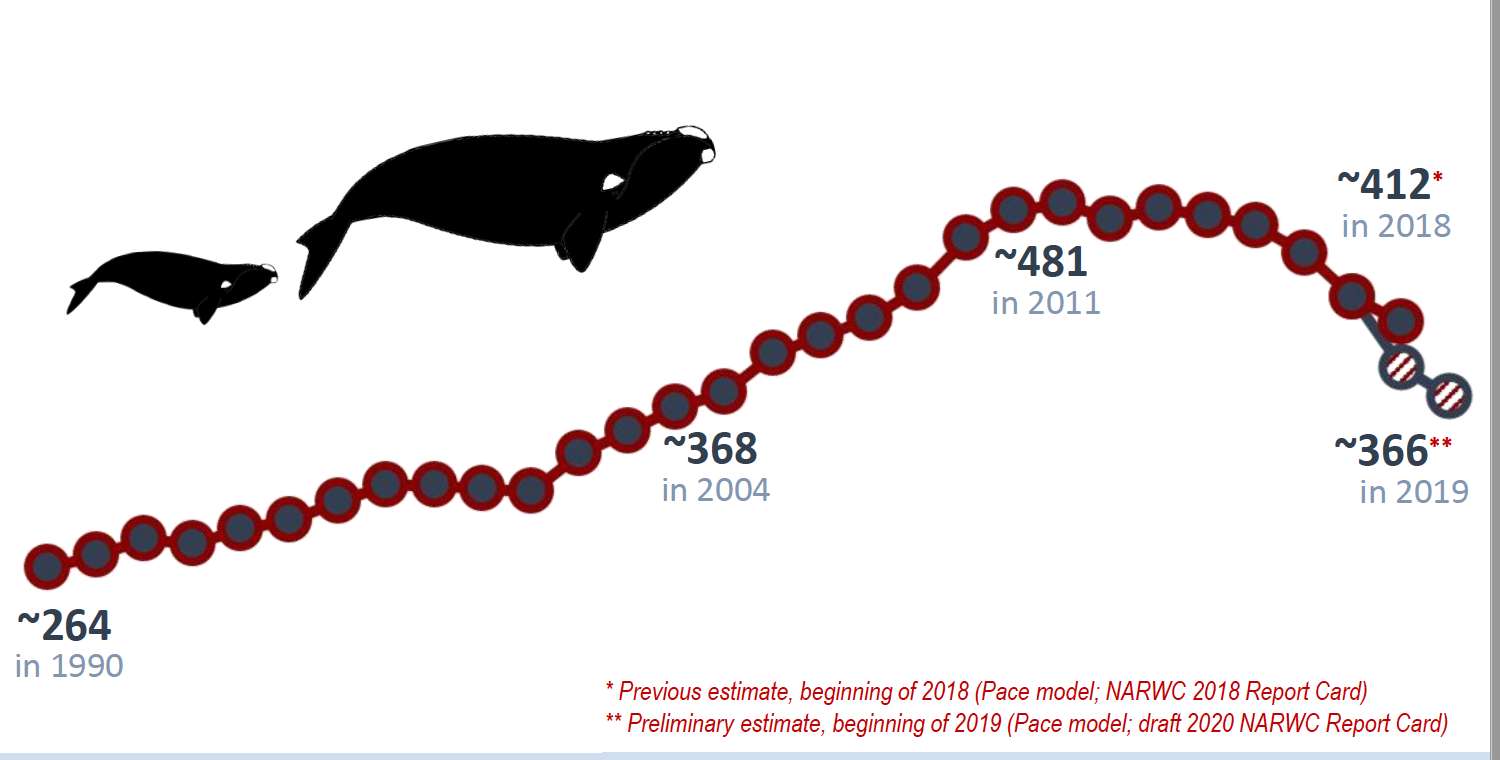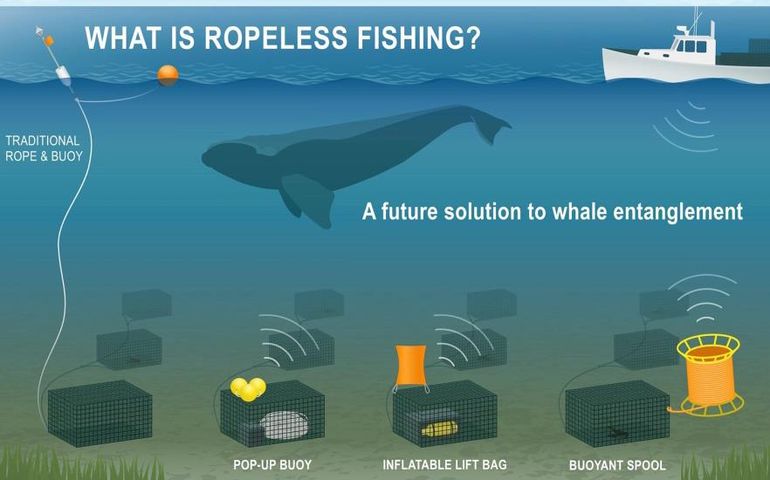
Processing Your Payment
Please do not leave this page until complete. This can take a few moments.
- News
-
Editions
View Digital Editions
Biweekly Issues
- Nov. 17, 2025
- November 03, 2025
- October 20, 2025
- October 6, 2025
- September 22, 2025
- September 8, 2025
- + More
Special Editions
- Lists
- Viewpoints
-
Our Events
Event Info
Award Honorees
- Calendar
- Biz Marketplace
Ropeless fishing, called ‘crazy’ by some, could be real in five years
 Courtesy / Northeast Fisheries Science Center
This image shows three types of ropeless fishing on the right, compared with the use of a traditional rope connected to a surface buoy, on the left.
Courtesy / Northeast Fisheries Science Center
This image shows three types of ropeless fishing on the right, compared with the use of a traditional rope connected to a surface buoy, on the left.
The possibility of hauling lobster traps from the ocean’s bottom by using an acoustic signal rather than a length of rope has been called crazy and viewed as impossibly expensive by many in the lobster industry.
But trials underway off the Massachusetts coast could be moving the impossible to the realm of reality, according to Sean Hayes, chief of the protected species branch at the Northeast Fisheries Science Center in Woods Hole, Mass.
Although the trials are in Massachusetts, Maine is the nation’s biggest lobster fishery, with over 100 million pounds landed last year.
Hayes presented an update on the technology to the New England Fishery Management Council at its virtual meeting in earlier this month.
Studies of the technology were launched in response to the decline of the endangered North Atlantic right whale, which migrates through U.S. and Canadian waters that also are lobstering grounds. Vessel collisions and fishing gear entanglements are considered the two leading causes of injury and death of the whales.

The center proposed a ropeless fishing technology program in late 2017 and began studying the options in 2018 using internal funding. In 2020, the center received $1 million in federal funds to accelerate the program, Hayes said.
The center has been working on the project with about 10 fishermen, most from Massachusetts.
“Ropeless” fishing involves removing the vertical line that connects the trap on the ocean’s bottom to a surface buoy, and instead provides a remote-control mechanism to raise the trap.
There are different styles of retrieval systems to recover the traps; all rely on an acoustic communication system between the fishing vessel and the gear on the bottom, Hayes explained.
A trap can be pre-set with a lifting device, such as a pop-up buoy, air-filled lift bag or a buoyant spool. An acoustic signal sent from a digital device on the vessel triggers the release of the lifting device, and raises the trap to the surface.
Successful tests
Ropeless technology may be an alternative to a ban on fishing in areas frequented by the whales, at least during certain times of the year.
The Northeast Fisheries Science Center has been working with 10 companies on ropeless systems. Several options are commercially viable and one company has told the center it could produce 100,000 units within two years and 1 million units within six years.
The center has also been experimenting with a timer-release system. And custom ropeless systems are being designed for different depths.
“We’ve had a lot of successful testing in shallow waters in the Massachusetts fishing area,” Hayes said.
The pandemic curtailed tests that were planned in offshore waters this year. But some offshore testing still happened and revealed that the logistics of working in deep water were challenging: Some boats were successful, others had difficulty retrieving gear.
Hayes said a major challenge is the potential for gear conflict issues between fishermen who use mobile gear — such as fishing boats that drag nets on the ocean’s bottom — versus fishermen who use traps, which stay in one place on the bottom.
In the trap fishery, buoys on the vertical line system provide visual markers that give mobile-gear operators a general sense of where gangs of traps are located.
Hayes said the technology could be available for low-density fishing areas within five years and, potentially, significantly sooner depending on cost. The goal is to try ropeless fishing first in areas with minimal gear conflict, with a small group of fishermen. As that group becomes more comfortable with the technology and shares their thoughts with others, the industry as a whole might see its feasibility, and the technology could spread into more complex habitats, Hayes said. At the same time, he said, chart-plotting technology could evolve that makes it possible for fishermen to "see" where each other’s gear is.
“There’s the social awareness of the solution and the technological component to the solution,” he said.
The center aims to promote social awareness through workshops with stakeholders, he added.
The center is also looking at how much ropeless fishing might cost individual fishermen, he said. The prototypes can cost thousands of dollars per unit.
“We know that’s just not feasible,” he said.
The expectation is that the cost will become substantially cheaper as mass production kicks in, but there’s no projection yet of what the price tag might be.
The discussion came on the heels of new findings that the estimated number of North Atlantic right whales plummeted from 483 in 2010 to 366 whales as of January 2019.
Mainebiz web partners
Sorry my friend, but ropeless technology is here and it is feasible. It will need the input of more lobstermen like yourself in order to be successful. Try to be part of the solution. You know that Maine gear isn't marked so even if it was found on a whale you wouldn't be blamed. Also, damage is done to 80% of the current population from visible rope scars.

The Giving Guide
The Giving Guide helps nonprofits have the opportunity to showcase and differentiate their organizations so that businesses better understand how they can contribute to a nonprofit’s mission and work.
Learn More
Work for ME
Work for ME is a workforce development tool to help Maine’s employers target Maine’s emerging workforce. Work for ME highlights each industry, its impact on Maine’s economy, the jobs available to entry-level workers, the training and education needed to get a career started.
Learn More
Groundbreaking Maine
Whether you’re a developer, financer, architect, or industry enthusiast, Groundbreaking Maine is crafted to be your go-to source for valuable insights in Maine’s real estate and construction community.
Learn more-
The Giving Guide
The Giving Guide helps nonprofits have the opportunity to showcase and differentiate their organizations so that businesses better understand how they can contribute to a nonprofit’s mission and work.
-
Work for ME
Work for ME is a workforce development tool to help Maine’s employers target Maine’s emerging workforce. Work for ME highlights each industry, its impact on Maine’s economy, the jobs available to entry-level workers, the training and education needed to get a career started.
-
Groundbreaking Maine
Whether you’re a developer, financer, architect, or industry enthusiast, Groundbreaking Maine is crafted to be your go-to source for valuable insights in Maine’s real estate and construction community.
ABOUT
NEW ENGLAND BUSINESS MEDIA SITES
No articles left
Get access now
In order to use this feature, we need some information from you. You can also login or register for a free account.
By clicking submit you are agreeing to our cookie usage and Privacy Policy
Already have an account? Login
Already have an account? Login
Want to create an account? Register
Get access now
In order to use this feature, we need some information from you. You can also login or register for a free account.
By clicking submit you are agreeing to our cookie usage and Privacy Policy
Already have an account? Login
Already have an account? Login
Want to create an account? Register







3 Comments